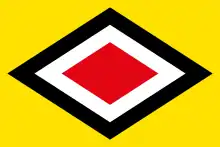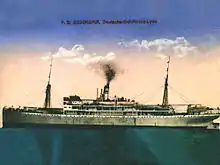Deutsche Ost-Afrika Linie
Deutsche Ost-Afrika Linie (German East Africa Line) was a shipping line, established in 1890 as an alternative to the existing shipping services to East Africa, including German East Africa (1891–1919), then dominated by United Kingdom shipping lines.
 | |
| Industry | Shipping, transportation |
|---|---|
| Founded | 1890 |
Area served | East Africa, Indian Ocean |


Founding
In 1888, the board of the trading firm Woermann-Linie made plans to set up a scheduled service to East Africa as the existing routes were dominated by British lines. The following year the Reichstag approved such a shipping line and in January 1890 the Chancellor began looking for a German shipping company to set up a line to Africa subsidized for over ten years with 900,000 marks a year. As no company was ready, the Reich announced the establishment of a shipping company.[1] On April 19, 1890, the Deutsche Ost-Afrika Linie was founded with a capital of six million marks by a consortium of German banks and the Hamburg merchants Adolph Woermann, F.Laeisz, August Bolten, and Hansen & Co. C. Woermann took over the management with Adolph Woermann as Chairman of the Supervisory Board.[2] The line began operating on July 23, 1890 with two steamers purchased from the Woermann line. Beginning in 1891, the service consisted of weekly departures from Hamburg via the Mediterranean to Bombay-Zanzibar.
Early Years
The first years of operation were quite difficult due to the British takeover of Zanzibar in November 1890 and the loss of two ships in the first three years. By 1894, the routes were extended to South Africa and profits were posted for the first time. In 1900 the government contract with annual subsidies of 1.35 million marks was extended by 15 years and the share capital increased to ten million marks. In 1901, a bond for five million marks was issued to build more ships.
In 1894 the company added a route from Hamburg to Durban in South Africa via the Cape and commissioned for this service the "Herzog" (1896/4,933 gt) and the "Koenig". In 1895 DOAL introduced instead the new steamers on the route Hamburg - Suez - Dar es Salaam and from 1898 also Durban was connected via Suez, no longer via Cape Town, in order to avoid a clash with the British. Only from 1901, when the Boer War was no longer a political obstacle, a new 'Rund-um-Afrika' (round Africa) route was operated by DOAL on the circuit Hamburg - Bremerhaven - Cape Town - Suez - Hamburg and in reverse direction. For this main line the 'Kronprinz' and 'Kurfürst' were introduced, steamers with a grey hull, white superstructure and a buff funnel, topped with an arrangement of black/white/red rings, pointing the national colours.
More difficult years followed until 1907, as new competitors appeared and the British lines increased competition. The Deutsche Ost-Afrika Linie and the Woermann Line then responded to an offer by Albert Ballin to form a joint venture with Hamburg-America Line (HAPAG). HAPAG and Woermann participated in the operation of the Deutsche Ost-Afrika Linie and each allocated one or two ships for an extension of the line from South Africa to West Africa. The Woermann Line was involved in the shared service and in 1908 the Hamburg-Bremen Africa Line also joined. The increased number of departures improved business.
After the death of Adolph Woermann in 1911, Eduard Woermann succeeded him. In 1914 the company's fleet consisted of 22 steamers, with approx. 110,000 BRT.
World War One & its Aftermath
The subsidy contract of 1900, which expired in 1915, was not extended as a result of the war. In 1916 Woermann sold the Woermann Line and the Deutsche Ost-Afrika Linie to a consortium made up of HAPAG, Norddeutscher Lloyd (NDL) and Hugo Stinnes.[2] The company lost all ships due to the First World War and the Versailles Treaty.
The Stinnes shares were taken over by HAPAG and NDL in 1921.[2]
In 1927 the Deutschen Afrika-Dienst-Vertrag of 1907 was continued for a further 20 years and in the following years the corporate structure stabilised. In 1928 the 9,552-ton "Watussi" and "Ubena" were introduced as the first two-funnel turbine steamers of the company sporting the DOAL label, employed on the 'Rund-um-Afrika' route.
A year after the NSDAP Nazi Party seized power, German shipping was reorganized in 1934, in which the large shipping groups were divided. HAPAG and Norddeutscher Lloyd had to surrender their shares in the Woermann Line and the Deutsche Ost-Afrika Linie to the German Reich. In 1936 two larger turbine steamers were launched, the "Pretoria" and the "Windhuk" of 16,662 tons each.
In 1942, during World War II, this line and the Woermann-Linie owned by the cigarette manufacturer Philipp Fürchtegott Reemtsma, were taken over by John T. Essberger of Nazi Germany.[1] The Deutsche Afrika-Linien lost both fleets in post-war reparations.
Ships of the Deutsche Ost-Afrika Linie up until 1914
| Name | Shipyard | GRT | Length [m] | Passengers | Launch/ Enter Service | Notes |
|---|---|---|---|---|---|---|
| Kronprinz | Blohm & Voss Nr. 140 | 5645 | 125.3 | 188 | 10.04.1900 30.06.1900 | Between-deck accommodation for 116 men. Interned in Lourenco Marques at the outbreak of war in 1914. Was confiscated by the Portuguese. Renamed 'Quelimane' and used as a hospital ship from October 1916 until the end of 1917. Returned to passenger service for Companhia de Transportes do Estado until 1927 when it was scrapped[3] |
| Kurfürst | Reiherstiegwerft Nr. 407 | 5654 | 125.2 | 270 | 9.07.1901 13.10.1901 | Whilst homebound ran aground on the Portuguese coast and sank on the 6th of May 1904[3] |
| Bürgermeister | Flensburger SG Nr. 210 | 5945 | 125.3 | 250 | 27.02.1902 19.06.1902 | Passed in 1919 to France: renamed 'Macoris' Broken up in 1935[4] |
| Prinzregent | Blohm & Voss Nr. 164 | 6341 | 126.8 | 175 | 10.01.1903 6.04.1903 | Between-deck accommodation for 120 men, Passed in 1919 to France: renamed 'Cordoba' Broken up in 1932[4] |
| Feldmarschall | Reiherstiegwerft Nr. 410 | 6142 | 126.7 | 268 | 21.02.1903 24.06.1903 | Between-deck accommodation for 120 men. On the 17th of August 1915 came under fire from HMS Hyacinth and was damaged, repaired by the British and put into service as 'Field Marshall', in 1922 sold to China, sunk in 1947[5] |
| Admiral | Blohm & Voss Nr. 178 | 6341 | 126.8 | 264 | 25.06.1905 23.09.1905 | Between-deck accommodation for 106 men, in 1914 the ship was in Lourenco Marques and sought protection, confiscated in 1916 by Portugal: renamed 'Lourenco Marques', scrapped in 1950 [6] |
| Prinzessin | Blohm & Voss Nr. 182 | 6387 | 126.8 | 298 | 23.12.1905 20.04.1906 | Passed to Britain in 1919 then to France in 1921: Renamed 'General Voyron', scrapped in 1934[6] |
| General | Blohm & Voss Nr. 203 | 8063 | 136.9 | 283 | 13.07.1910 25.02.1911 | Between-deck accommodation for 70 men, undertook war service in Smyrna, Constantinople as an accommodation and sickbay vessel for the Turkish war effort, confiscated in 1918 in Odessa by France: renamed 'Azay le Rideau', scrapped in 1937[7] |
| Tabora | Blohm & Voss Nr. 211 | 8022 | 136.9 | 316 | 18.04.1912 29.06.1912 | Renamed HS Tabora suspected of masquerading as hospital ship. Sunk by a British ship HMS Vengeance (1899) in Dar es Salaam harbour on 23 March 1916,[8] |
| Kigoma | Reiherstiegwerft Nr. 451 | 8156 | 137.0 | 310 | 30.01.1914 28.04.1914 | Passed to British in 1919 then to France in 1921: renamed Algeria, in 1922 was purchased by HAPAG, renamed Toledo, returned to Africa service in 1927, scrapped in 1934[9] |
Ships of the Deutsche Ost-Afrika Linie after 1914
| Name | Shipyard | GRT | Length [m] | Passengers | Launch/ Enter Service | Notes |
|---|---|---|---|---|---|---|
| Windhuk | Blohm & Voss Nr. 588 | 16662 | 175.8 | 490 | 1936 | At outbreak of WW2 was disguised as Santos Maru and entered port of Santos, Brazil. Remained interned until 1942, when Brazil entered war with Allies, the crew sabotaged all the machinery. Repaired and did service as USS Lejeune from 1943 for the US Navy. Scrapped in Portland 1966 |
| Ussukuma | Blohm & Voss Nr. 389 | 7834 | 127.6 | 264 | 20.12.1920 08.07.1921 | At outbreak on WW2 was at Lorenço Marques, commandeered by Abwehr fled across Atlantic to Argentine coast, after engagement with HMS Ajax was scuttled by crew on 5th of December 1939 off Necochea |
See also
- Deutsche Afrika-Linien/John T. Essberger Group of Companies
- German East Africa topics
- East Africa Protectorate
- Kenya Colony
References
- Rübner, Hartmut: Konzentration und Krise der deutschen Schiffahrt. Maritime Wirtschaft im Kaiserreich, in der Weimarer Republik und im Nationalsozialismus, Hauschild Verlag, Bremen 2005
- Mathies, Otto: Hamburgs Reederei 1814 - 1914. Friederichsen Verlag, Hamburg 1924.
- Arnold Kludas: Die Schiffe der deutschen Afrika-Linien 1880 bis 1945. Verlag Gerhard Stalling, 1975, ISBN 3-7979-1867-4
- Kludas: Schiffe der Afrika-Linien, S. 48.
- Kludas: Afrika-Linien, S. 50.
- Kludas: Afrika-Linien, S. 57
- Kludas: Afrika-Linien, S. 65
- Kludas: Afrika-Linien, S. 65f.
- Kludas: Afrika-Linien, S. 66.
External links
| Wikimedia Commons has media related to Deutsche Ost-Afrika Linie. |
